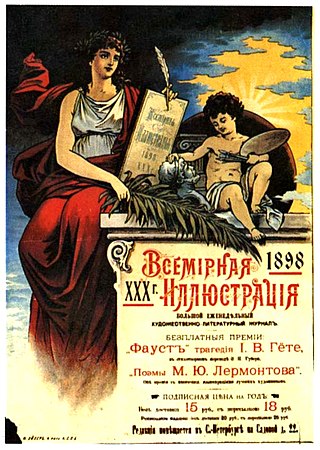
Novodevichy Cemetery is a cemetery in Moscow. It lies next to the southern wall of the 16th-century Novodevichy Convent, which is the city's third most popular tourist site.

Peredvizhniki, often called The Wanderers or The Itinerants in English, were a group of Russian realist artists who formed an artists' cooperative in protest of academic restrictions; it evolved into the Society for Travelling Art Exhibitions in 1870.
The following is a chronological list of classical music composers who live in, work in, or are citizens of Russia, or who have done so.

People's Artist of the RSFSR was an honorary title granted to Soviet Union artists, including theatre and film directors, actors, choreographers, music performers, and orchestra conductors, who had outstanding achievements in the arts, and who lived in the Russian Soviet Federative Socialist Republic (RSFSR). This title was one rank below Honored Artist of the RSFSR and one above People's Artist of the USSR.

Vsemirnaya Illyustratsiya was a Russian weekly magazine founded by German Goppe and published by his own publishing house in Saint Petersburg in 1869–1898.
The 1st Don Cossack Division was a Don Cossack cavalry division of the Russian Imperial Army. It was part of the 19th Army Corps in the Warsaw Military District.
The leaders of the Russian Civil War listed below include the important political and military figures of the Russian Civil War. The conflict, fought largely from 7 November 1917 to 25 October 1922, was fought between numerous factions, the two largest being the Bolsheviks and the White Movement. While the Bolsheviks were centralized under the administration of the Russian Soviet Federative Socialist Republic and the Russian Communist Party (Bolsheviks), led by Vladimir Lenin, along with their various satellite and buffer states, the White Movement was more decentralized, functioning as a loose confederation of anti-Bolshevik forces united only in opposition to their common enemy - though from September 1918 to April 1920, the White Armies were nominally united under the administration of the Russian State, when, for nearly two years, Admiral Alexander Kolchak served as the overall head of the White Movement and as the internationally recognized Head of State of Russia. In addition to the two primary factions, the war also involved a number of third parties, including the anarchists of the Revolutionary Insurgent Army of Ukraine, and the non-ideological Green Armies.